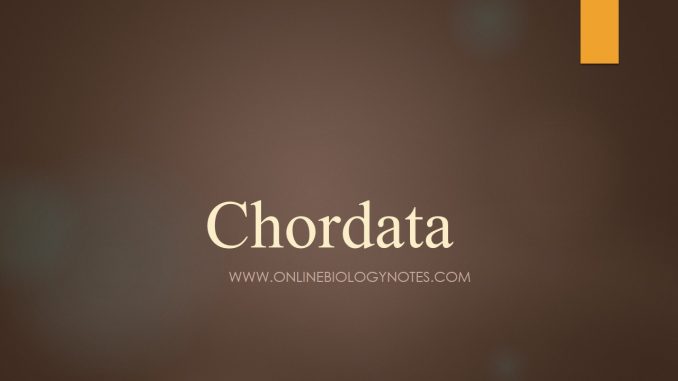
Characteristics of Phylum Chordata
- (Noton; back and chorda; cord).
- Kingdom: Animalia
- Presence of a notochord
- They are backboned animals (vertebrates),
- Most of the living chordates are familiar vertebrate animals.
- Presence of dorsal hollow nerve cord
- Blood vascular system: Present, closed type
- Ventral heart, hepatic portal system and RBC are present.
- Germ layer: Triploblastic.
- Symmetry: bilateral symmetry body.
- Coelom: Present. Well developed
- Presence of gill (pharyngeal) slits
- Presence of post anal tail
Phylum Chordata is divided into four sub-phylum:
- Hemichordata,
- Urochordata,
- Cephalochordata
- vertebrata or Craniata
1. Sub-Phylum: Hemichordata
- (hemi: half; chorde: cord)
- Habitat: exclusively marine
- Notochord present only in anterior region
- Notochord is also known as Buccal diverticulum
- Body is soft worm like
- Body is divided into Probosis, collar and trunk
- Sexes are separate
- Fertilization: external
- Examples: Balanoglossus, Cephalodiscus, Atubaria
2. Sub-phylum: Urochordata
- ( uros: tail; chorde: cord)
- Habitat: marine
- Notochord present only in tail region of tadpole larvae
- Adult lack tail and organ for locomotion
- Sex: Hermaphrodite
- Fertilization: Cross and external
- Development: indirect
- Examples: Hermania, Salpa, Doliolum
3. Sub-phylum: Cephalochordate
- (kephalo: head; chorde: cord)
- Notochord present from head to tail and persist throughout life
- Pharynx is well developed with numerous gill slits
- Coelom present
- Body resemble small fish like
- Circulatory system well developed
- Sexes: separate
- Fertilization: external
- Development: indirect
- Examples; Amphioxus, Asymmetron
4. Subphylum: Vertebrata
- (vertebra: backbone)
- Also known as craniate)
- Habitat: Aquatic as well as terrestrial
- Notochord is replaced by vertebrae or backbone
- Germ layer: triploblastic
- Symmetry: bilateral
- Body divided into head, trunk and tail
- Excretion: a pair of kidney
- Circulation system: closed type
- Blood pigment present
- Sexes: separate
- Fertilization; internal or external
The vertebrata is sub-divided into two divisions:
i. Agnatha (Lack jaw) and
ii. Gnathostomata (Possess jaw).
- The Gnathostomata are further divided into six classes:
- Chondrichthyes, Osteichthyes, Amphibia, Reptilia, Aves and Mammalia.
